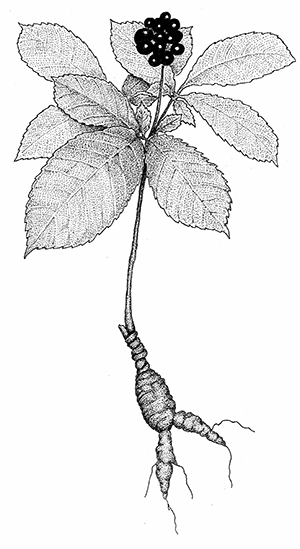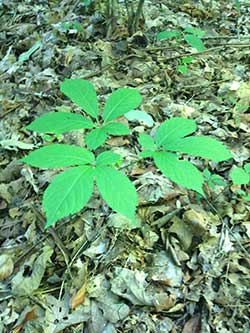The Ginseng Dealer Application is active only Aug. 1-30 annually.
Ginseng Information
Ginseng was discovered in the mountains of Northern China more than 5,000 years ago. Although first used as food, the plant became popular for medicinal purposes especially in Asia.
Three species are medicinally important:
- Korean ginseng (Panax ginseng)
- Chinese ginseng (Panax notoginseng)
- American ginseng (Panax quinquefolius)
Pioneers to North America both used and traded American ginseng. It was exported to China as early as 1717 and remains a major export. Chinese and Korean ginseng have been overharvested to near extinction in Asia. There, plants in the wild are rare. American ginseng grows naturally in North America in 19 states and two provinces of Canada. American ginseng is vulnerable to overharvesting because of slow growth, low seed production, and loss of forest habitat.
Ginseng in Indiana
Ginseng grows throughout Indiana. Small groups or solitary plants can be found in shady hardwood forest on moist, rich, well-drained soil. Generally, there is not much competing ground cover. The future of Indiana’s ginseng harvest is dependent upon the careful stewardship and harvesting by root diggers and dealers. Read about wild ginseng conservation in Indiana
Description

One or more leaf stalks sprout from a central stem. The 3-5 toothed “leaves” at the base of each stalk are actually leaflets. These leaflets and their stalk make up one leaf or prong.
- First-year plants are only about two inches tall and have one leaf (prong) with three leaflets.
- Second and third year plants have two prongs with 5 leaflets each.
- Plants four years or older are 12-14 inches tall and have three prongs with five leaflets. The two leaflets at the prong base are smaller than the three. Plants older than four years may have 3-5 prongs, each with 5 leaflets.
- A large taproot, often with smaller “tails” forking off the main root, develops over several years. It is this taproot that has medicinal and economic value.
Aging plants
As American ginseng drops foliage in the fall, it develops a leaf scar on the tap root where the leaves grew out of it. Each year, a new leaf scar is formed on top of the previous year’s scar. These stacked scars form what is collectively known as the “root neck.” Since one scar is formed every year, plants can be aged by counting the number of scars on the root neck.
Harvesting
Harvesting mature ginseng is relatively easy and done with a digging stick or trowel. In Indiana, plants cannot be legally harvested before five years of age. It is illegal to dig the taproot until a plant has 3 or 4 prongs. Harvesting younger plants prevents them from producing seed to reproduce themselves. Ginseng cannot reproduce until it is 3 or 4 years old. At that time, it bears a round cluster of pale green flowers in April-May. These flowers produce a fruit cluster that turns bright red when ripe, about the middle of August. Planting seeds near where the roots have been dug, under the leaf litter but on the soil surface, will greatly increase chances of new plants replacing those harvested. This is required by rule 312 IAC 19-1-8. Contact a dealer for further advice on the proper techniques for digging and drying ginseng.
The purpose of Indiana’s ginseng program (Public Law 107 (IC 14-31-3) and Ginseng Rule (312 IAC 19) is to ensure a healthy population for the future. The harvest season was instituted to encourage replanting of the seeds when they are ripe and insure that only mature plants are taken. Registration of dealers and certification of ginseng is required in order to monitor the health of the population. The selling season was established for this purpose. Ginseng that is bought for resale must be certified by a Indiana Conservation Officer. By monitoring reports from dealers it is easier to determine if ginseng is declining and needs further protection.
- Ginseng Harvest Report 2023-2024
- Ginseng Harvest Report 2022-2023
- Information for dealers and exporters including required exporting permits from the U.S. Fish & Wildlife Service, International Affairs Division. Use search term "American Ginseng."
Ginseng Licensing
Licensing for Ginseng in Indiana depends on if you are a harvester, producer, or a dealer.
You are a harvester if you intend to only harvest and sell Ginseng. You are a producer if you intend to grow and sell your own crop. Neither of these positions need a license.
If you intend to buy and sell Ginseng, you are a dealer, and you do need a license. You can apply for a dealer's license between Aug. 1 and 30 by clicking here for the application and paying the associated fee. Before applying for a license, please review the "Know the law" and "Interested in Becoming a Dealer" sections below.
You must first establish an Access Indiana account. If you have a previous Access Indiana account for a hunting or fishing license, you may use the credentials for that account.
Being a Ginseng dealer requires you to adhere to state and federal laws and regulations regarding Ginseng, including using the Ginseng portal (and attending required training). If your application is approved, you will receive notification via the email associated with your account on or around. Aug. 31. Applications outside the approved dates will not be considered.
Seasons
Harvest
Sept. 1 - Dec. 31 of current year. Harvesters can legally dig wild ginseng. Harvesters do not need a license to dig ginseng nor sell ginseng to a licensed dealer.
Selling
Sept. 1 of current year to March 31 of next year. Dealers can legally purchase ginseng from harvesters. When reselling ginseng purchased directly from harvesters, the dealer must fill out a form certifying the ginseng’s origin and weight. A copy of the certification must accompany the ginseng when it is shipped.

Know the law
- It is illegal to harvest wild ginseng out of season. A Class A misdemeanor.
- To harvest legally, a ginseng plant must have: at least 3 prongs and a flowering or fruiting stalk, or at least 4 internodes on the rhizome. To harvest plants not meeting these criteria is a Class B infraction.
- It is required that mature fruits and any seeds on the harvested ginseng be planted in the vicinity where the plant was dug and in a manner that encourages germination.
- It is required that the entire stalk and leaves be retained with the plant until it is taken to the harvester’s residence or place of business, unless the root has at least 4 internodes on the rhizome.
- It is illegal to sell or remove mature fruits and seeds from the vicinity where the ginseng was taken.
- It is illegal to buy, sell, or possess any ginseng out of season without written authorization from the Department of Natural Resources, Division of Law Enforcement. A Class B misdemeanor.
- It is illegal to buy uncertified ginseng for resale without an Indiana Ginseng Dealer’s License. A Class B misdemeanor.
- Only certified ginseng can be sold to a buyer in another state. To export uncertified ginseng is a Class A misdemeanor.
- Harvest ginseng only where it is permitted—digging on State property is not allowed; digging on private property without permission is theft; digging on other properties may require a permit.
- Anyone violating these rules will be prosecuted.
Interested in becoming a dealer?
The commercial buying and selling of the plant is a serious undertaking. Reporting and sales are highly regulated.
1. Before seeking a license, discuss your desire with:
- The Indiana DNR Ginseng Coordinator in the Division of Nature Preserves.
- A current ginseng dealer.
- A DNR Conservation Officer in your area.
2. Study the history and ecology of ginseng and understand:
- Indiana laws and regulations.
- Federal laws from the U.S. Fish & Wildlife Service.
- U.S. Fish & Wildlife Service Ginseng information.
3. Understand the seasonal requirements, limits and consequences.
4. Contact the DNR Ginseng Coordinator with any questions.
Once a dealer:
- Apply every August for annual license, submitting payment with application.
- Know your harvesters.
- Report any suspicion of illegal activity to a DNR Conservation Officer.
